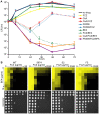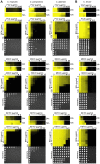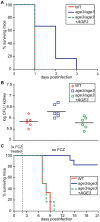Reverse genetics in Candida albicans predicts ARF cycling is essential for drug resistance and virulence
- PMID: 20140196
- PMCID: PMC2816695
- DOI: 10.1371/journal.ppat.1000753
Reverse genetics in Candida albicans predicts ARF cycling is essential for drug resistance and virulence
Abstract
Candida albicans, the major fungal pathogen of humans, causes life-threatening infections in immunocompromised individuals. Due to limited available therapy options, this can frequently lead to therapy failure and emergence of drug resistance. To improve current treatment strategies, we have combined comprehensive chemical-genomic screening in Saccharomyces cerevisiae and validation in C. albicans with the goal of identifying compounds that can couple with the fungistatic drug fluconazole to make it fungicidal. Among the genes identified in the yeast screen, we found that only AGE3, which codes for an ADP-ribosylation factor GTPase activating effector protein, abrogates fluconazole tolerance in C. albicans. The age3 mutant was more sensitive to other sterols and cell wall inhibitors, including caspofungin. The deletion of AGE3 in drug resistant clinical isolates and in constitutively active calcineurin signaling mutants restored fluconazole sensitivity. We confirmed chemically the AGE3-dependent drug sensitivity by showing a potent fungicidal synergy between fluconazole and brefeldin A (an inhibitor of the guanine nucleotide exchange factor for ADP ribosylation factors) in wild type C. albicans as well as in drug resistant clinical isolates. Addition of calcineurin inhibitors to the fluconazole/brefeldin A combination only initially improved pathogen killing. Brefeldin A synergized with different drugs in non-albicans Candida species as well as Aspergillus fumigatus. Microarray studies showed that core transcriptional responses to two different drug classes are not significantly altered in age3 mutants. The therapeutic potential of inhibiting ARF activities was demonstrated by in vivo studies that showed age3 mutants are avirulent in wild type mice, attenuated in virulence in immunocompromised mice and that fluconazole treatment was significantly more efficacious when ARF signaling was genetically compromised. This work describes a new, widely conserved, broad-spectrum mechanism involved in fungal drug resistance and virulence and offers a potential route for single or improved combination therapies.
Conflict of interest statement
The authors have declared that no competing interests exist.
Figures








Similar articles
-
Candida and candidaemia. Susceptibility and epidemiology.Dan Med J. 2013 Nov;60(11):B4698. Dan Med J. 2013. PMID: 24192246 Review.
-
Calcineurin A of Candida albicans: involvement in antifungal tolerance, cell morphogenesis and virulence.Mol Microbiol. 2003 May;48(4):959-76. doi: 10.1046/j.1365-2958.2003.03495.x. Mol Microbiol. 2003. PMID: 12753189
-
PKC signaling regulates drug resistance of the fungal pathogen Candida albicans via circuitry comprised of Mkc1, calcineurin, and Hsp90.PLoS Pathog. 2010 Aug 26;6(8):e1001069. doi: 10.1371/journal.ppat.1001069. PLoS Pathog. 2010. PMID: 20865172 Free PMC article.
-
Synergistic effect of calcineurin inhibitors and fluconazole against Candida albicans biofilms.Antimicrob Agents Chemother. 2008 Mar;52(3):1127-32. doi: 10.1128/AAC.01397-07. Epub 2008 Jan 7. Antimicrob Agents Chemother. 2008. PMID: 18180354 Free PMC article.
-
The genetic basis of fluconazole resistance development in Candida albicans.Biochim Biophys Acta. 2002 Jul 18;1587(2-3):240-8. doi: 10.1016/s0925-4439(02)00087-x. Biochim Biophys Acta. 2002. PMID: 12084466 Review.
Cited by
-
A Small Molecule Inhibitor of Erg251 Makes Fluconazole Fungicidal by Inhibiting the Synthesis of the 14α-Methylsterols.mBio. 2023 Feb 28;14(1):e0263922. doi: 10.1128/mbio.02639-22. Epub 2022 Dec 8. mBio. 2023. PMID: 36475771 Free PMC article.
-
The Monoterpene Carvacrol Generates Endoplasmic Reticulum Stress in the Pathogenic Fungus Candida albicans.Antimicrob Agents Chemother. 2015 Aug;59(8):4584-92. doi: 10.1128/AAC.00551-15. Epub 2015 May 26. Antimicrob Agents Chemother. 2015. PMID: 26014932 Free PMC article.
-
pH-Dependant Antifungal Activity of Valproic Acid against the Human Fungal Pathogen Candida albicans.Front Microbiol. 2017 Oct 9;8:1956. doi: 10.3389/fmicb.2017.01956. eCollection 2017. Front Microbiol. 2017. PMID: 29062309 Free PMC article.
-
Impairing the interaction between Erg11 and cytochrome P450 reductase Ncp1 enhances azoles' antifungal activities.Nat Commun. 2025 Jul 24;16(1):6821. doi: 10.1038/s41467-025-62131-z. Nat Commun. 2025. PMID: 40707518 Free PMC article.
-
The molecular mechanism of azole resistance in Aspergillus fumigatus: from bedside to bench and back.J Microbiol. 2015 Feb;53(2):91-9. doi: 10.1007/s12275-015-5014-7. Epub 2015 Jan 28. J Microbiol. 2015. PMID: 25626363 Review.
References
-
- Nucci M, Marr KA. Emerging fungal diseases. Clin Infect Dis. 2005;41:521–526. - PubMed
-
- Wilson LS, Reyes CM, Stolpman M, Speckman J, Allen K, et al. The direct cost and incidence of systemic fungal infections. Value Health. 2002;5:26–34. - PubMed
-
- Shao PL, Huang LM, Hsueh PR. Recent advances and challenges in the treatment of invasive fungal infections. Int J Antimicrob Agents. 2007;30:487–495. - PubMed
Publication types
MeSH terms
Substances
Grants and funding
LinkOut - more resources
Full Text Sources
Molecular Biology Databases

